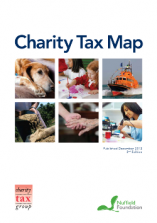A brief history of the Tax Map
 The idea of exempting charitable organisations from certain taxes has been widely accepted for over 400 years, and the importance of protecting such exemptions is clear.
The idea of exempting charitable organisations from certain taxes has been widely accepted for over 400 years, and the importance of protecting such exemptions is clear.
The fact remains, however, that while there are some instances in which charities do have to pay tax, what these taxes are and what monetary burden they inflict have been poorly understood. The idea for a Charity Tax Map first emerged in 2007, when charity sector representatives decided that they needed a resource for explaining this hidden tax burden to people – both within and without the sector.
The main objective of the Tax Map is to provide an explanation of the provisions of the tax system with which charities have to comply – and the applicable reliefs. The original Charity Tax Map, published in February 2011, set out in some detail 18 different taxes that can affect charities, and the multiple tax regimes and procedures with which charities have to comply in order to administer them.
The first Tax Map was immediately successful, and was recognised as an authoritative text on charity taxation. However, it soon became clear that the pace at which policy and legislation grew and changed meant that a more interactive, sustainable resource was required. While a second edition of the Charity Tax Map was published 18 months later – endorsed with a foreword by Sajid Javid MP – planning began for an online Tax Map.
This resource is intended to provide all of the information present in the older Maps, while being both more accessible and more adaptable. For the first time, charities will be able to search for relevant information based on the types of taxes they pay or the activities they undertake.
This is a resource by charities, for charities and we encourage you to use it regularly and help us to keep it up-to-date, informative and practical to use.